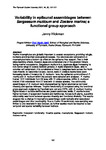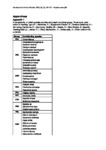Variability in epifaunal assemblages between Sargassum muticum and Zostera marina: a functional group approach
| dc.contributor.author | Hickman, J. | |
| dc.date.accessioned | 2021-12-24T17:05:34Z | |
| dc.date.available | 2021-12-24T17:05:34Z | |
| dc.date.issued | 2021 | |
| dc.identifier.citation |
Hickman, J. (2021) 'Variability in epifaunal assemblages between Sargassum muticum and Zostera marina: a functional group approach', The Plymouth Student Scientist, 14(2), pp. 107-127. | en_US |
| dc.identifier.uri | http://hdl.handle.net/10026.1/18500 | |
| dc.description.abstract |
Marine macrophytes are globally important to coastal ecosystems, providing refugia, nutrients and important ecological processes. The structure and composition of macrophytes have a bottom-up effect on the epifauna they support. Due to their wide-reaching effects, invasive algae are considered one of the greatest threats facing marine ecosystems. Sargassum muticum is a Japanese algae increasing its non-native range in coastal habitats globally. A highly dispersive algae, able to colonise soft substratum, it is considered a threat to seagrass beds across the North East Atlantic. In Salcombe Estuary, Devon, beds of Zostera marina have seen increasing levels of invasion by S. muticum. Here, the epifaunal communities of Z. marina and S. muticum within the estuary were sampled and analysed. Z. marina hosted 1041 individuals from 36 taxa, with 11 unique species, whilst S. muticum hosted 2106 individuals from 37 taxa with 12 unique species. The community assemblages of S. muticum were characterised by higher abundance but lower diversity and species richness. Trophic functionality is compared using the functional group approach designed by Fauchald and Jumars (1979), with S. muticum hosting higher levels of surface detritivores and jawed carnivores, whilst Z. marina hosted higher numbers of suspension feeders and herbivores. Across both plants, a positive relationship was found between species diversity and functional diversity. The results suggest that a change in macrophyte assemblage could radically alter associated assemblages and thus functionality. Due to Covid-19 restrictions, data sampling was limited to one weekend in late October, so further studies would be required to test temporal and spatial variability between habitats. | en_US |
| dc.language.iso | en | en_US |
| dc.publisher | University of Plymouth | en_US |
| dc.rights | Attribution 3.0 United States | * |
| dc.rights.uri | http://creativecommons.org/licenses/by/3.0/us/ | * |
| dc.subject | Ecosystem functionality | en_US |
| dc.subject | invasive species | en_US |
| dc.subject | macrophytes | en_US |
| dc.subject | Sargassum muticum | en_US |
| dc.subject | Zostera marina | en_US |
| dc.title | Variability in epifaunal assemblages between Sargassum muticum and Zostera marina: a functional group approach | en_US |
| dc.type | Article | en_US |
| plymouth.issue | 2 | |
| plymouth.volume | 14 | |
| plymouth.journal | The Plymouth Student Scientist |




